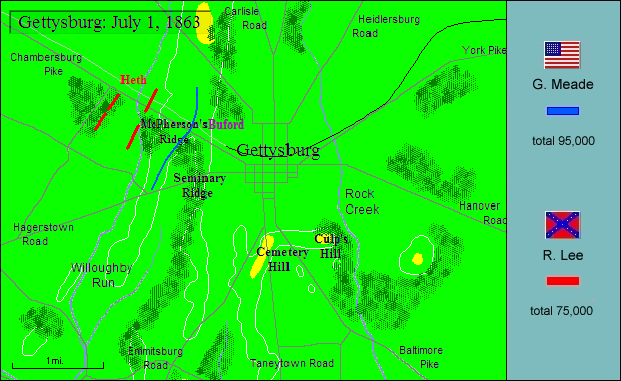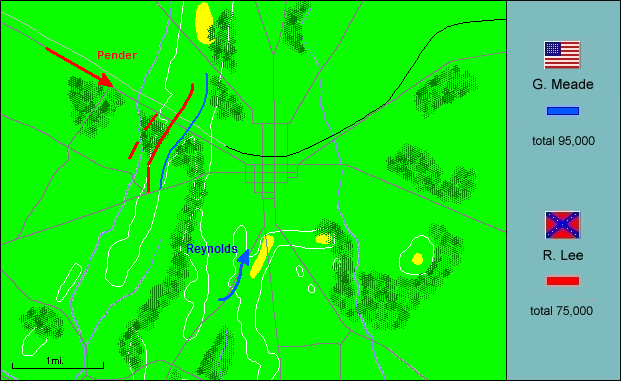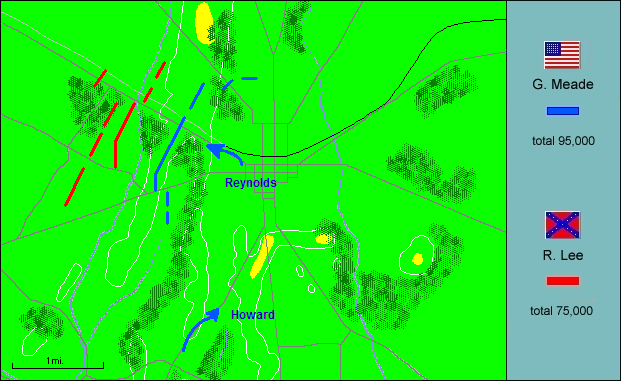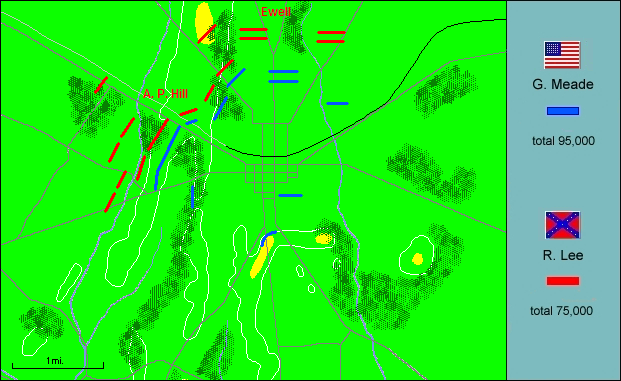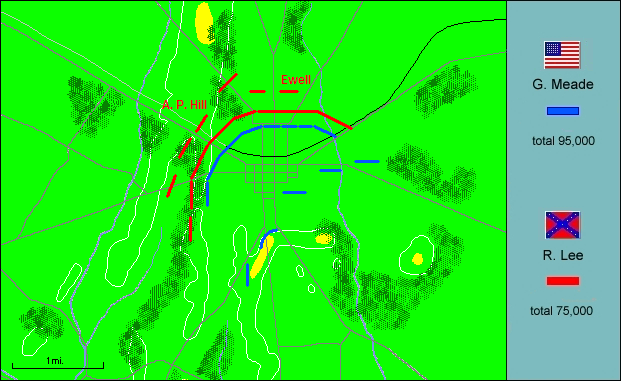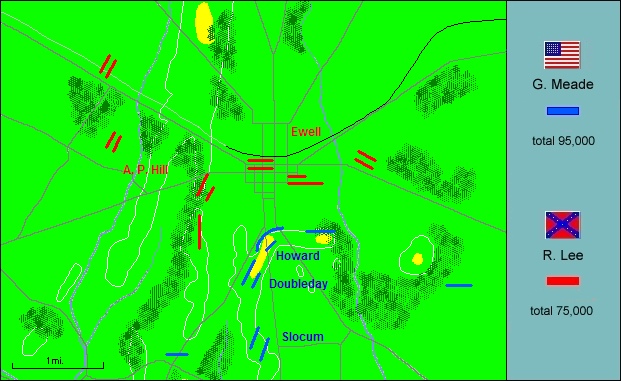The enemy is there, and I am going to attack him there.
–Robert E. Lee
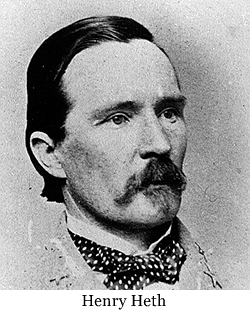
Buford, as it happens, was watching the fight through his field glasses from the ridge beyond that, in the cupola of the Lutheran seminary there, and could see that two brigades of cavalry would not long hold off a division of infantry. Then, too, reports told him to expect more trouble from the north, another column of infantry, Ewell’s, on its way down from Carlisle. While Buford was considering, John Reynolds reached the seminary on horseback. The lead elements of his corps were an hour or so behind on the Emmitsburg road to the south. Did Buford think he could hold this position until they came up? Buford thought he might. Reynolds was considered one of the most capable soldiers in the army by officers and men alike, and he acted now with dispatch. James Wadsworth’s division was already on the way. Now he called for Howard and Sickles’s corps to march on Gettysburg as fast as they could drive. To Meade back in Taneytown, he reported Rebels in strength at Gettysburg as well as his resolve to “fight them inch by inch, and if driven into the town I will barricade the streets and hold them back as long as possible.” Then he galloped back to bring Wadsworth’s two brigades up himself. The fire-fight begun on the banks of Willoughby Run was about to blow up into a vast and violent fire-storm.
It was ten o’clock when he reached Buford again, coming over Seminary Ridge and up the Chambersburg Pike at last. With Buford’s men now just about to be pushed off the crest of McPherson’s Ridge, Reynolds sent one brigade to their right and one to their left. Riding forward on the left himself, Reynolds could see that the race to hold the ridge was going to be a near thing. “Forward, forward, men!” he shouted. “Drive those fellows… Forward! For God’s sake, forward!” Then he was dead, struck behind the right ear by a Rebel Minie ball while defending his native state.
Across the way, Heth could see that it was going to take more than skirmishers to break the Yankees, and he directed Archer and Davis to send their battle lines over the run and up the ridge, Archer south of the pike, Davis north. As Archer’s men went up the slope, they got more than they bargained for: added to the fast-firing Spencers were volleys of rifle fire. In line now on the Yankee left were the men of the crack Iron Brigade in their distinctive black hats. Those Rebels who thought–or hoped–that the only infantry they would encounter today would be militia or home guards now shouted, “Look at them black hats!… That’s the Army of the Potomac.” The tough veterans broke the grey attack and drove it back down the slope. In the confusion of getting back across the run, some 75 Confederates were captured when a Michigan regiment fell on their flank from the south. Among the captured was Archer himself. The battle was only hours old, and one general was dead and another a prisoner of war. On the north end of the ridge, Yankee infantry had not yet reached the crest to support Buford’s troopers. There Davis–the president’s nephew–took his green brigade up the slope and broke the Yankee line, sending bluecoats in flight toward Seminary Ridge in the rear. Davis’ triumph turned to trouble in short order, however. Just north of the pike and parallel to it was the deep cut of an unfinished railroad. It seemed to Davis and his men a perfectly good sap leading to the Federal rear. Once in it in numbers, however, they discovered it was too deep to shoot out of. Abner Doubleday, now in corps command in Reynold’s place, hustled two regiments from the left over to the railroad cut, and Davis’ men were trapped in their trench. Half his brigade were casualties or prisoners before the morning was out.
Abner Doubleday, who did not invent baseball in Cooperstown, New York, but who did fire the first Union shot at Sumter, thought the situation now–it was just noon–was encouraging. The initial Confederate attack had been beaten back and two grey brigades badly mauled. Buford had done more than yeoman service, holding the ridge until infantry could come up. Two other I Corps divisions, Doubleday’s own and John Robinson’s, were up now, and Howard’s XI Corps was arriving as well. But the battle was about to be lifted to the next degree of fury. Coming down from the north on the Mummasburg Road was the lead division of Ewell’s corps, that of Robert E. Rodes, and Rodes believed he saw a rich opportunity. It was the Federals’ exposed right flank on the ridge. Supported by Rebel artillery from Oak Hill, the northern heights of McPherson’s Ridge, Rodes could, if he hurried, smash up Doubleday’s right. He would need to hurry because across the way Howard, now the senior on the field, had already seen the danger there and was both getting reinforcements forward and bending the line back to the east to meet Rodes’ threat. About two o’clock Rodes, with one brigade on his left to check any sudden Yankee thrust from the town and one in reserve, sent three brigades forward. The brigade in the center was dreadfully cut up when it ran into Yankees hidden behind a stone wall on their flank, but the brigade on the right managed to strike and crush the critical right-angle in Doubleday’s line where it bent east. Rodes’ left-most brigade, having stalled at first, now went forward again, and this time it found a quarter-mile gap between Doubleday’s right and Howard’s left. Flanked left and right, there was nothing for Doubleday’s men on the eastern end of the line to do but fall back toward Seminary Ridge in their rear. At this point, things went from bad to worse for the Federals. Just as Doubleday’s right was collapsing, Jubal Early’s division arrived from York by way of the Harrisburg Road and pitched immediately into the fight on Howard’s extreme right. Now the Federals had Rebels pressing from the west, north, and northeast. Under the weight of Early’s attack, Howard’s two divisions north of the town were beginning to buckle.
Three Confederate divisions–Heth, Rodes, and Early’s–were now engaged, and two more–Dorsey Pender and Dick Anderson’s–were just coming up behind Heth on the Chambersburg Pike. On the Federal side elements of two corps–Reynolds’ (now Doubleday’s) and Howard’s–were engaged, and Sickle’s corps was hurrying to Gettysburg from the south. Despite Lee’s orders to avoid a general engagement, the battle established a dynamic of its own. Lee, however, reached the field from Chambersburg about two o’clock and was going to do what he could to direct events. The trouble was he could see no more of the disposition and strength of the Federals than he could see from his position on Herr Ridge just west of McPherson’s Ridge where the fight had commenced. “I cannot think what has become of Stuart,” Lee repeated. “In the absence of reports from him, I am in ignorance of what we have in front of us here. It may be the whole Federal army, or it may be only a detachment. If it is the whole Federal force, we must fight a battle here.” It was a battle Lee certainly did not want to fight blind, and if he had to fight it, he did not want to fight until Longstreet was up. About 2:30, however, Henry Heth appeared. Seeing Rodes’ attack making slow headway from the northwest, he asked Lee for permission to strike another blow from the west across Willoughby Run. Lee at first refused; then, as the battle unfolded before him, he could see Rodes’ men widen the gap between Doubleday and Howard, and Howard’s divisions in blue already wavering under the weight of Early’s attack. At this point, Lee made a fateful decision: the battle he had come to win on Northern soil would be at Gettysburg. He sent Heth forward once more across the run and up the ridge and a little later Pender’s division for good measure. Now the Yankees, outnumbered and outflanked, were in a world of trouble.
Old Jubal’s men had the easiest time of it. Coming down the Harrisburg Road in a rush, they fell with a shock on the exposed right flank of Howard’s two Dutch divisions. The service of most of these men in the Army of the Potomac had been nothing but defeat and disaster. In fact, these were the very same men Stonewall Jackson had run over in the Wilderness just two months ago. This day was no luckier for them. They broke up at the first blow and went streaming back through the streets of the town. Nor was it much of a day for the two division commanders. Francis Barlow, a New York lawyer before the war, was shot from his horse trying to rally his routed men. Prussian-born Alexander Schimmelfennig simply rode the wave of retreat into Gettysburg, caught a bullet there, and spent the remainder of the battle hiding in a woodshed. Rodes’ division, after its initial repulse in the center, continued to press its attack on Doubleday’s men, who were now compelled to fall back southward along Seminary Ridge. The fight was fiercest on Heth and Pender’s front to the west. There the five regiments of Solomon Meredith’s Iron Brigade were determined not to yield their stretch of McPherson’s Ridge south of the pike despite the fact that Yankee resistance north and east of it was collapsing everywhere. The collision of just two regiments suggests the savagery of the fighting all along the ridge. The 24th Michigan went into the fight with nearly 500 men; it came out with 97. The grey regiment opposite, Johnston Pettigrew’s 29th North Carolina, had an even higher casualty rate. One of its companies charged up the slope with 91 men, and every last one went down dead or wounded. At last, though, Pender’s division got south of the Yankees and fell hard on their left. The Iron Brigade survivors fell back through the town. Of the 1,800 men who had run up the ridge to Buford’s rescue that morning 1,200 were now dead, wounded, or captured. Pettigrew’s adjutant, who had been in many a hot fight, thought this “the deadliest of them all.” In sum, the fighting west and north of the town on July 1 accounted for 8,000 Confederate casualties and 9,000 Federal.
As the last Yankees were being cleared from Seminary Ridge, Lee rode forward to take a look from its crest. He had won the first round of the fight, that was clear enough, as bluecoats streamed in confusion through the now crowded streets of Gettysburg. A half-mile due south of the town, however, the Yankees had stopped running and were preparing to make a stand. They found excellent ground on which to do so: Cemetery Hill (so-called for the burying ground there) directly behind the town and a rocky ridge running a half-mile east to a second and slightly higher summit, Culp’s Hill, looking down on Rock Creek just below its eastern slope. Lee, as ever, was determined not to let those people on the heights so much as catch their breath. The situation was uncertain. He had prisoners from six divisions, he knew, but how close to hand the rest of Meade’s army was was harder to say. Certainly, he wanted to push those people off the high ground before dark. Lee wanted the aggressive Powell Hill and his corps to do the pushing. Hill, however, uncharacteristically declined. He had himself risen from a sick-bed that morning to reach the field. (Throughout the war Hill was in uncertain and inconstant health until his death in front of Petersburg at the bitter end.) More to the point, though, was the fact that of his three divisions, Heth’s had been badly mauled in the day-long fight, Pender’s disorganized by its own smashing success, and Anderson’s was still on the road. It would have to be Rodes and Early from Ewell’s corps (Edward Johnson’s division was still on its way from Cashtown). About 4:30 to Dick Ewell–Old Bald Head to his men–Lee sent a second discretionary order: “to carry the hill occupied by the enemy, if practicable.” Lee’s career-long habit of allowing subordinates wide individual latitude in carrying out his general designs had served him well with Jackson. But Dick Ewell of course was no Stonewall Jackson, and in the end Ewell did not think an attack just then practicable. What might have been achieved before dark on July 1 has been a matter of conjecture ever since. One thing is certain, however; the prospects would be much tougher the next day.
Meanwhile, about the same time Lee’s order went by courier to Ewell, Longstreet arrived to confer with Lee. (His corps was still waiting for Johnson to clear the single road from Cashtown.) Presently Old Peter began to study the ground around Gettysburg through his field glasses. He liked what he saw. The line of high ground ran in what is inevitably described as a long fishhook. It ran from Culp’s Hill, the point of the hook, west to Cemetery Hill, then down the long shank of Cemetery Ridge due south to a rocky hill known as Little Round Top, and finally to the eye of the hook, another higher, rocky hill, Round Top. Though Federals were busy with pick and shovel between Culp’s and Cemetery Hill, the Round Tops were unoccupied. “If we could have chosen a point to meet our plans of operation,” Pete declared, “I do not think we could have found a better one than that upon which [the Federals] are now concentrating.” To Longstreet, the next move was as inexorable as logic itself. All they needed to do was to swing the army around the Federal left. It would put them between Meade’s army and Washington and compel him to come out and fight on Confederate ground. If the Yankees didn’t come out and attack tomorrow, the army could simply fall back to a prepared position still closer to Washington and ready themselves to receive the attack that Meade must inevitably make. It was exactly the design that Longstreet understood the campaign to take when the army had pulled out of Fredericksburg back in June: offensive in strategy, defensive in tactics. Lee, however, now as then, understood no such thing. He had driven the bluecoats today; he would drive them again tomorrow. No, he told his warhorse: “The enemy is there, and I am going to attack him there.” Still, Pete was going to have his say: “If he is there, it will be because he is anxious that we should attack him: a good reason, in my judgment, for not doing so.” But today the only judgment that mattered was Robert Edward Lee’s. Again, he answered, no: “They are there in position, and I am going to whip them, or they are going to whip me.” After the war, when Lee had ridden off into legend, much of the blame for the failure at Gettysburg would fall on Longstreet’s shoulders. But on this first of July, with the sun sliding down the sky to the west, the decision to stay on the offensive was entirely Lee’s. This much Old Peter understood about his chief with absolute certainty: “When the hunt was up, his combativeness was overruling.” Perhaps Lee was also thinking of the men who could go anywhere and do anything if properly led.

